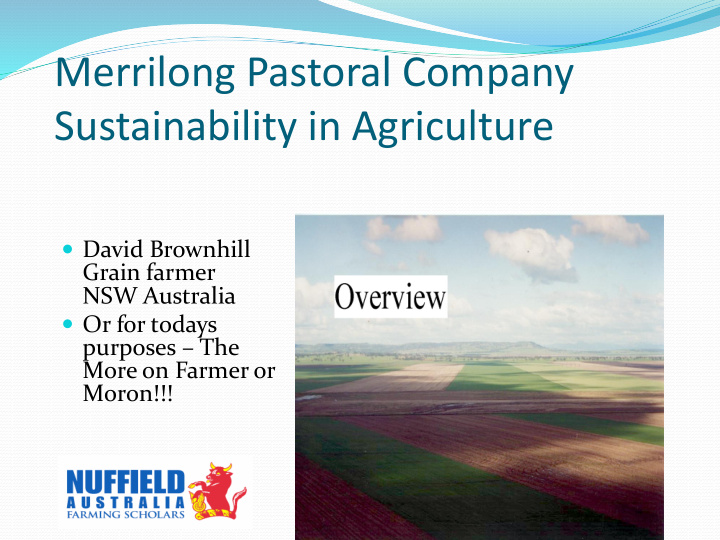



Merrilong Pastoral Company Sustainability in Agriculture David Brownhill Grain farmer NSW Australia Or for todays purposes – The More on Farmer or Moron!!!
Intoduction Merrilong Pastoral Company 6477 hectares ( 16 000 acres) on the Liverpool Plains Fertile clay based soil The business is operated with my brother and his family Merrilong Pastoral Company aims to be profitable whilst enhancing its environment
Merrilong Pastoral Company Purchased first farm in 1959 Originally sheep, fat lambs and cattle Cropping began in earnest in the late 60’s Summer cropping began in 1970’s No tillage first adopted in 1980’s Full no till system mid 1990’s Controlled traffic farming system 2003 Guidance etc etc!!
Merrilong Pastoral Company Issues in the Farming System Erosion Hard to kill weeds Glyphosate resistant weeds Reliance on herbicides Crop disease Heavy residue to plant into High input farming system - nutrition
Merrilong Pastoral Company Issues in the business Staff management Weather and Rain – or usually lack of it Business planning Finding the next opportunity Growing the business Planning for the next generation Volatility and Risk
Merrilong Pastoral Company Crops grown include bread wheat, durum wheat, chickpeas, barley, cotton, sorghum, maize, feed corn, summer legumes and seed crops 3800 hectares of dryland farming land 1410 hectares of pivot and flood irrigation 1400 hectares grazing land Grain Storage capacity of 13000 tonnes on farm Yields range from 0 to 10 tonnes per ha
Merrilong Pastoral Company The Fundamentals of the business Soil Health Moisture Stubble retention, erosion minimisation People and Family Profit and Passion Enjoying what we do
Maximising Production The world is a hungry place Australia is export orientated We only have 22 million people We have limited moisture, fragile soils and markets which are volatile Our goal is to minimise risks, control what we can
Controlled traffic – minimising compaction
Tramlines for controlled traffic Centre row
All crops are planted inter row – barley into sorghum stubble
Summer crop planting
Sorghum – yields have increased
Selective Spraying in action
Balance sheet rules Equity Range 100% 95% 90% 85% 80% 75% 70% 65% 60% 55% 50% 1996 1997 1998 1999 2000 2001 2002 2003 2004 2005 2006 2007 2008 2009 Equity % Target Range - High Target Range - Low
Business drivers Returns Expenditure and costs Scale Plant and equipment Land Use If you can’t measure it, you can’t manage it
Operating Return on Assets 25% 20% 15% 10% 5% 0% Your Farm Farms Top 20% Average Bottom 20%
Liverpool Plains - ROAM% Variance over five years 25.00% 20.00% 15.00% ROAM% 10.00% 5.00% 0.00% 11 15 17 1 19 13 4 3 14 -5.00%
Scale and Profitability 25% Operating Return on Assets Managed (%) 20% 15% 10% 5% 0% 0 1000 2000 3000 4000 5000 6000 Area Managed (ha)
Plant Ratios 450 6.0 400 Farm Income:Plant Value 5.0 Plant Cost / area cropped ($/ha) 350 300 4.0 250 3.0 200 150 2.0 100 1.0 50 0 0.0 Top 20% Average Bottom 20% Plant Cost Plant Ratio
Land Use 100% 80% 60% % 40% 20% 0% Top 20% Average Bottom 20% Pasture Crop Fallow
Pillar Crops and knowing your numbers Reviewing rotations
Sorghum low risk Sorghum Net Income 1500 Hectares Sorghum $ 2 701 500 If substituting Cotton for Sorghum An additional 1500 Hectares Cotton over $ 435 000 Sorghum
But cotton comes with risk 2012 – I can give you just under one million reasons why not to grow cotton!!! Crop disease can strike at any time But What is the black swan of sorghum production??
Merrilong 1959
Merrilong, Noongah, Gowrie, Keralla Downs , Dimby Plains, Mooki Springs, Inveraray Downs -2013
Recommend
More recommend